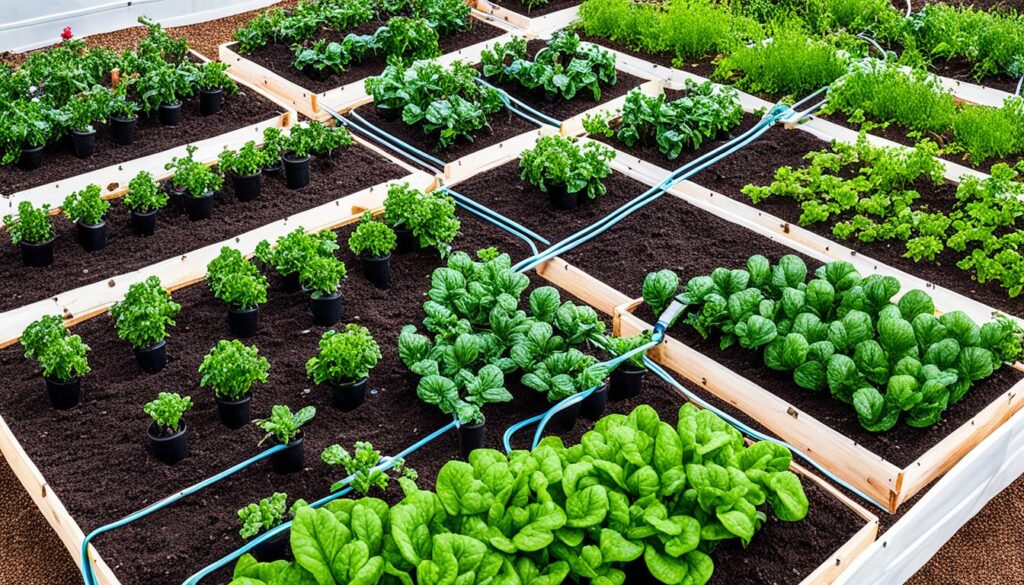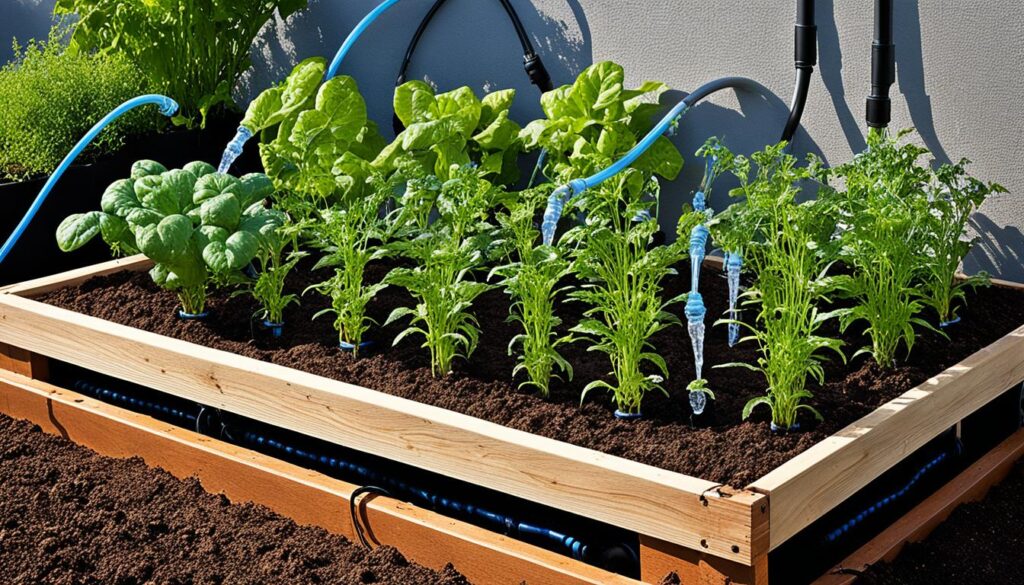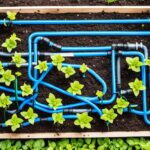DIY watering solutions for raised gardens
Irrigation Solutions for Raised Bed Gardens: Keeping Your Plants Hydrated
Are your raised bed gardens getting the proper hydration they need to thrive? The key to lush and productive plants lies in efficient irrigation techniques. But with so many options available, how do you choose the best irrigation system for your raised beds? In this article, we will explore the world of raised bed irrigation and provide you with valuable insights and tips to keep your plants hydrated and healthy.
Key Takeaways:
- Proper irrigation is essential for the health and growth of plants in raised bed gardens.
- Under-watering or over-watering can lead to stressed and unhealthy plants.
- Understanding the importance of proper watering and its impact on plant health is crucial.
- There are various irrigation solutions and techniques available to efficiently water your raised bed gardens.
- Choosing the right irrigation system is vital for promoting consistent and even watering.
Importance of Proper Watering in Raised-Bed Gardens
Adequate watering is crucial for the success of raised-bed gardens. Under-watering or over-watering can result in stressed and unhealthy plants. Proper watering ensures that plants receive the right amount of moisture to support their vital functions such as photosynthesis and nutrient transportation.
When it comes to raised garden irrigation, efficient watering techniques are key to maintaining healthy plants and conserving water in raised beds. By practicing water conservation in raised beds, you not only promote sustainability but also save on water costs.
Efficient watering techniques in raised beds involve understanding the water needs of different plants and adapting your watering schedule accordingly. By closely monitoring the moisture levels in the soil, you can prevent both under-watering and over-watering.
Watering deeply but less frequently allows the plant roots to access water and nutrients from the deeper layers of soil, promoting stronger root growth. Additionally, watering in the morning helps minimize water evaporation, giving plants ample time to absorb the moisture they need before the heat of the day.
Proper Watering: Impact on Raised-Bed Gardens
Proper watering has a significant impact on the overall health and productivity of your raised-bed gardens. When plants receive the right amount of water, they can carry out essential processes such as photosynthesis more effectively, leading to sturdy growth and abundant yields.
“Water is the lifeblood of plants. By providing adequate hydration, you create an optimal environment for your plants to thrive.” – Gardening Tips and Techniques
By implementing efficient watering techniques, you also reduce the risk of plant diseases that can occur due to over-watering or inadequate drainage in raised beds. This helps maintain the longevity of your garden and ensures a beautiful and flourishing landscape.
Tips for Successful Watering in Raised-Bed Gardens
To ensure successful watering in your raised-bed gardens, there are a few key tips to keep in mind. By following these efficient watering techniques, you can maintain optimal moisture levels in your plants’ root zones and promote healthy growth.
Paying Attention while Watering
Spending time in your garden while watering allows you to spot any issues and make adjustments. This hands-on approach ensures that each plant receives proper hydration and avoids overwatering or underwatering. Regular observation helps you identify any signs of stress or water-related problems early on, allowing timely intervention.
Adjusting Watering Frequency with Weather Changes
It’s crucial to pay attention to weather conditions and adjust the frequency of watering accordingly. During hot and dry periods, plants may require more frequent watering to compensate for increased evaporation rates. Conversely, cooler and rainy weather may necessitate reducing watering frequency to prevent waterlogging and root rot. By adapting your watering schedule to the weather, you can ensure efficient water utilization and avoid water waste.
Understanding Plant Moisture Requirements
Each plant species has specific moisture requirements. Some plants prefer moist soil consistently, while others tolerate drier conditions. It’s essential to understand the watering needs of the plants in your raised-bed gardens to provide the appropriate amount of water. Conduct research or consult gardening resources to learn about the specific watering preferences of the plants you’re cultivating.
Watering Less Frequently but More Deeply
Instead of shallow and frequent watering, it’s advisable to water less often but deeply. This technique encourages plants to develop deeper root systems, enhancing their stability and resilience. Deep watering allows moisture to reach lower soil layers, reducing evaporation and promoting plant roots’ exploration of a larger soil volume.
Morning Watering and Using an Automatic Watering System
Watering in the morning is generally ideal as it allows foliage to dry before nighttime. This minimizes the risk of fungal diseases caused by moisture accumulation. To ensure consistent and even watering, consider using an automatic watering system. These systems can be set up with timers and deliver water directly to the root zones, avoiding wastage and promoting efficient irrigation.
DIY Raised Bed Irrigation
If you’re the hands-on type, consider implementing a DIY raised bed irrigation system. This allows you to customize the irrigation setup and make adjustments as needed. Popular DIY options include using soaker hoses, drip lines, or creating your own drip irrigation system using basic materials readily available at home or garden centers. DIY projects can be cost-effective and tailored to suit the specific dimensions and layout of your raised beds.
Implementing these efficient watering techniques and DIY raised bed irrigation systems can help you maintain optimal moisture levels for your plants, ensuring their health and vitality.

| Efficient Watering Techniques for Raised-Bed Gardens | Benefits |
|---|---|
| Paying Attention while Watering | Allows for personalized care and adjustments based on plant needs |
| Adjusting Watering Frequency with Weather Changes | Prevents overwatering or underwatering during different weather conditions |
| Understanding Plant Moisture Requirements | Optimizes watering for specific plant species |
| Watering Less Frequently but More Deeply | Promotes deep root development and reduces evaporation |
| Morning Watering and Using an Automatic Watering System | Minimizes disease risk and ensures consistent irrigation |
| DIY Raised Bed Irrigation | Customizable and cost-effective irrigation solutions |
Choosing the Best Irrigation System for Raised Beds
When it comes to keeping your raised beds adequately hydrated, choosing the right irrigation system is essential. There are several options available, each with its own advantages and considerations. Let’s explore some of the popular choices and help you make an informed decision.
Drip Irrigation for Raised Beds

Drip irrigation is an efficient and precise watering technique for raised beds. It involves a network of tubes or pipes with small emitters that release water directly to the base of each plant. This system minimizes water waste by delivering water only where it’s needed, reducing evaporation and runoff. Drip irrigation also keeps the foliage dry, reducing the risk of diseases. It’s an excellent choice for raised beds with closely spaced plants, promoting optimal growth and minimizing weed growth.
Raised Bed Watering Systems
If you’re looking for a comprehensive solution, consider raised bed watering systems. These systems are specifically designed for raised beds, offering convenience and efficiency. They typically involve a combination of drip irrigation, soaker hoses, or micro-sprinklers that provide precise and even watering. Raised bed watering systems save time and effort by automating the watering process, ensuring your plants receive consistent moisture.
DIY Raised Bed Irrigation
DIY raised bed irrigation is a cost-effective option that allows you to customize your watering system according to your specific needs. It involves using easily accessible materials like PVC pipes, connectors, and drip emitters to create your irrigation system. DIY solutions can be as simple or complex as you prefer, offering flexibility to adapt to the size and layout of your raised beds.
When choosing the best irrigation system for your raised beds, consider factors such as your budget, the size of your garden, plant spacing, and personal preferences. Evaluate the pros and cons of each system and select the one that aligns with your requirements. Remember, the key is to provide consistent and efficient irrigation for your raised beds, promoting healthy plant growth and abundant harvests.
Conclusion
Proper irrigation plays a critical role in the success of your raised-bed gardens. By following efficient watering techniques and selecting the best irrigation system for your raised beds, you can ensure that your plants receive the necessary hydration to thrive and grow. Whether you choose a DIY solution or invest in a professional irrigation system, the key is to provide consistent and even watering throughout your raised beds.
Implementing raised bed irrigation strategies will result in lush and healthy gardens. Optimal irrigation not only promotes the overall health of your plants but also boosts their productivity. With the right watering techniques and the best irrigation system for raised beds, you can enjoy the vibrant beauty of your plants and achieve a bountiful harvest.
Remember, efficient watering techniques such as watering in the morning, deep watering, and utilizing automatic watering systems are essential for raised bed gardens. The best irrigation for raised beds is the drip irrigation system, which provides direct water to the soil, ensuring even moisture distribution and reducing the risk of disease.
By prioritizing proper irrigation methods, you can create an environment that supports the growth and development of your plants. So, don’t overlook the importance of raised bed irrigation. Implement the right strategies, choose the best irrigation system, and watch your raised-bed gardens thrive and flourish with abundant greenery and beautiful blooms.
If you ever happen to be in our area please stop and say Hi at The Landscape Connection and if you would like to see more on the subject of Raised Bed Gardening and many others visit Michelle at the youtube channel @GardeningTLC
FAQ
Why is proper irrigation important for raised-bed gardens?
Proper irrigation is important for raised-bed gardens because it ensures that plants receive the right amount of moisture to support their vital functions and overall health. Under-watering or over-watering can result in stressed and unhealthy plants.
What are some tips for successful watering in raised-bed gardens?
Spending time in your garden while watering allows you to spot any issues and make adjustments. Paying attention to the weather and adjusting the frequency of watering accordingly is also crucial. Understanding the watering needs of your plants, watering less frequently but more deeply, watering in the morning, and using an automatic watering system can help ensure effective watering in raised-bed gardens.
What is the best irrigation system for raised beds?
There are several options to consider, including soaker hoses, sprinklers, drip lines, and DIY drip irrigation systems. Soaker hoses are affordable but may get clogged and water unevenly. Sprinklers can be effective, but they have the risk of wetting the foliage and promoting disease. Drip lines provide water directly to the soil and offer even watering, making them a preferred choice for raised beds.
How can I choose the best irrigation system for my raised beds?
When choosing an irrigation system, consider factors such as affordability, ease of setup, water distribution, and potential risks such as wetting the foliage. Drip lines are often the best choice as they provide even watering and water directly to the soil. DIY drip irrigation systems can also be explored for a customized solution.
For a comprehensive overview of Raised Bed Gardening, be sure to read our article: The Complete Guide to Raised Bed Gardening: Benefits, Design, and Maintenance
- Disclosure: This article contains affiliate links, which means we may receive a commission if you click on a link and purchase something that we have recommended. Please note that all opinions are our own, and we only recommend products and services that we believe will add value to our readers. Thank you for supporting The Landscape Connection and our site:growingourgarden.com!
- 10 Must-Have Blooms for Your 2025 Garden
- The Health Advantages of Gardening You Need to Know
- How to Create a Small Vegetable Garden Layout Plan: A Beginner’s Guide
- DIY Garden Projects for Small Spaces: Upcycling Ideas to Maximize Your Garden
- Watering Techniques for Small Gardens: Ensuring Your Plants Thrive
- Small Border Plants for Landscaping: Adding Beauty and Functionality to Your Garden
- Year-Round Small Space Gardening: Seasonal Planting Tips for Maximum Harvest
- Essential Tools for Small-Space Gardening: What You Really Need
- The Ultimate Guide to Container Vegetables: What to Grow in Small Spaces
- Budget-Friendly Gardening: How to Create a Thriving Garden on a Tight Budget
- How to Optimize Sunlight in Small Gardens: Tips for Better Plant Growth
- DIY Vertical Planters: Creative Ideas for Small Space Gardening
- Companion Planting for Small Vegetable Gardens: Boost Growth and Deter Pests
- Container Gardening Essentials: Choosing the Right Pots, Soil, and Plants
- Vertical Gardening Techniques: Maximizing Your Small Space with Climbers and Vines
- How to Build a Raised Bed Garden in a Small Backyard: Step-by-Step Guide
- The Best Vegetables for Small-Space Gardens: High-Yield Varieties You Need to Grow
- Smart Vegetable Garden Layouts for Small Spaces: Maximizing Your Green Thumb in Compact Areas
- 40. Best Practices for Managing a Sustainable Garden Year-Round
- Building a Wildlife Pond for Biodiversity
- Advanced Techniques in Sustainable Gardening
- How to Create a No-Till Garden
- The Mental Health Benefits of Gardening
- Using Technology to Enhance Sustainable Gardening
- Getting Certified Organic: Steps and Benefits
